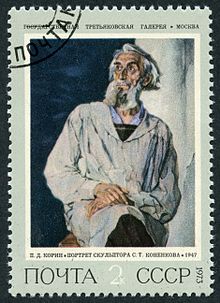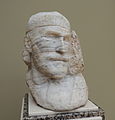Sergei Timofejewitsch Konjonkov

Sergei Timofeyevich Konjonkow ( Russian Сергей Тимофеевич Конёнков * June 28 . Jul / 10. July 1874 greg. In the village Karakowitschi in Roslavl ; † 9. December 1971 in Moscow ) was a Russian / Soviet sculptor .
Life
Konjonkow came from a farming family. He studied at the Moscow School of Painting, Sculpture and Architecture with a degree in 1897. In the same year he visited France , Italy and Germany . He then studied sculpture with WA Beklemischew at the Art School of the Russian Art Academy in St. Petersburg . His diploma thesis (made of clay ) Samson , Breaking the Shackles, was too revolutionary for his academy teachers to break them.
The Revolution of 1905 experienced Konjonkow in Moscow . Under the influence of events, he created the series of portraits of the fighters on Red Presnya Street. In 1905 he furnished the Filippowa Café on Moscow's Tverskaya Street and in 1910 created the bas-relief Das Gelage . He is working on a forest cycle using wood with different working techniques, since for him the forest represents the elementary force of nature. Examples of this work are the Stribog (1910) and the Beggar Brotherhood (1917). As one of the first Russian sculptors, he turned to the female nude . He was held in high regard and was known as the Russian Rodin .
Konjonkov supported the October Revolution and participated in the realization of the plan of monumental propaganda . His striving for monumentality became the dominant tendency of these years. New forms emerged in the bas-relief Favor in the Struggle for Peace and Brotherhood of Nations for the Moscow Kremlin Wall and the Stenka Razin Memorial for Red Square (1918–1919). In 1923 he took part in the design of the All-Russian Exhibition of Agriculture, Crafts and Industry in Moscow (the later exhibition of the achievements of national economy ).
In 1922 Konjonkow married the lawyer Margarita Ivanovna Voronzowa , with whom he traveled to the USA in late 1923 to participate in an exhibition of Russian and Soviet art. The trip was only supposed to take a few months, but they stayed and lived and worked in New York City . He dealt with biblical subjects, with the Apocalypse , and he represented Christ , the prophets and apostles . 1928–1929 Konjonkow traveled to Italy , held a personal exhibition in Rome and met Maxim Gorky , whom he portrayed as well as his granddaughter Marfa , whose daughter Nina and his daughter-in-law Nadeschka Alexejewna Peschkowa.
In 1935 Konjonkow was commissioned by Princeton University for a bust of Albert Einstein . Einstein valued Konjonkov's work, but also his wife Margarita, who was already acquainted with Robert Oppenheimer . During the Second World War Konjonkov was a member of the Russia Aid Committee .
In 1945, on the orders of Stalin, the ship Smolny brought the Konjonkows back to the USSR with all their works , and Konjonkow was given a studio in Moscow on Gorky Street. In 1947 he became a corresponding member of the Art Academy of the USSR and in 1954 a full member. In 1965 there was a Moscow exhibition of Konjonkov's works on the occasion of his 90th birthday.
Konjonkow portrayed IS Turgenev , WW Majakowski , KE Ziolkowski , ND Selinski and various composers, in particular JS Bach and N. Paganini . He created monuments for AS Pushkin , LN Tolstoy , VI Surikov and a memorial stone for MM Prishwin .
Konjonkov was buried in Moscow's Novodevichy Cemetery. On his gravestone is his self-portrait, for which he received the Lenin Prize. The Konyonkov Museum is located on Moscow's Tverskaya Street. Streets in Moscow, Smolensk and Roslavl were named after Konjonkov .
Honors
- Medal "For heroic work in the Great Patriotic War 1941–1945"
- 3rd class Stalin Prize (1951)
- People's Artist of the RSFSR (1955)
- Order of Lenin (1955) and (1964)
- Lenin Prize (1957) for his self-portrait
- People's Artist of the USSR (1958)
- Hero of Socialist Labor (1964)
- Honorary citizenship of Smolensk (1964)
Works
literature
- CT Konjonkow: My Century: Memories . Politisdat, Moscow 1971 (Russian, accessed March 25, 2016).
- LP Trifonowa: Sergei Timofejewitsch Konjonkow . Chudozhnik RSFSR, Leningrad 1975 (Russian).
- AA Kamenski: Konjonkow . Iskusstwo, Moscow 1975 (Russian).
- Sergei Semenow: Konjonkow Sergei Timofejewitsch (Russian, accessed March 25, 2016).
- ST Konjonkow (Russian, accessed March 25, 2016).
- Konjonkow Sergei Timofejewitsch (Russian, accessed March 25, 2016).
Individual evidence
- ↑ Konjonkov's Bible (Russian, accessed March 25, 2016).
- ↑ Einstein in love (Russian, accessed March 25, 2016).
- ↑ JA Fedosjuk: Moscow within the garden ring . Moskowski Rabotschi, Moscow 1991, pp. 52-62, ISBN 5-239-01139-7 (Russian).
- ↑ Sergei Timofejewitsch Konjonkow (Russian, accessed on March 25, 2016).
- ^ Konjonkow Museum (Russian, accessed March 25, 2016).
Web links
| personal data | |
|---|---|
| SURNAME | Konjonkow, Sergei Timofejewitsch |
| ALTERNATIVE NAMES | Konenkov, Sergei Timofeevich; Конёнков, Сергей Тимофеевич (Russian) |
| BRIEF DESCRIPTION | Russian-Soviet sculptor and university professor |
| DATE OF BIRTH | July 10, 1874 |
| PLACE OF BIRTH | Karakovichi village near Roslavl |
| DATE OF DEATH | December 9, 1971 |
| Place of death | Moscow |





